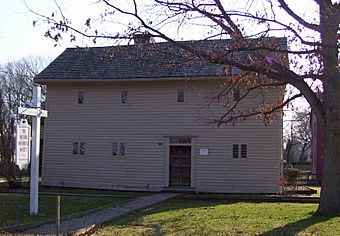Eells-Stow House facts for kids
Quick facts for kids |
|
|
Eells-Stow House
|
|

The Eells-Stow House on the Milford Historical Society property, Milford, Connecticut.
|
|
| Location | 34 High St., Milford, Connecticut |
|---|---|
| Area | 1 acre (0.40 ha) |
| Built | c. 1700–1720 |
| Architectural style | First Period |
| NRHP reference No. | 77001407 |
| Added to NRHP | June 17, 1977 |
The Eells-Stow House is a special historic building located at 34 High Street in Milford, Connecticut. It is now a historic house museum, which means people can visit it to learn about the past. This house was built around 1700, making it one of the oldest buildings still standing in Milford. Over the years, parts of the house were added or changed. Because of its long history, it was added to the National Register of Historic Places in 1977. Today, the Milford Historical Society takes care of this important piece of history.
About the Eells-Stow House
The Eells-Stow House is part of the Milford Historical Society's property. It sits on High Street, close to the center of Milford. The house is made of wood and has two and a half stories. It has a pointed roof and its outside walls are covered with clapboards.
The front of the house has four window openings. A large chimney is in the middle, and the main door is also on the front. A section that leans off the back of the house was likely added in the late 1700s. This gives the house a unique shape, often called a saltbox style. Inside, you can see parts of the original building. These parts show how the house was built in different stages over many years.
A Look Back in Time
The oldest part of the Eells-Stow House was built around 1700. It was built by Samuel Eells, who was an important person in Milford at that time.
Later, during the American Revolutionary War, the house belonged to Stephen Stowe and his wife, Freelove (Baldwin) Stow. Stephen Stowe made a brave choice during the war. He agreed to house and care for prisoners of war who had become sick with smallpox. This was a very dangerous disease back then. Sadly, Stephen Stowe caught smallpox himself while caring for the soldiers and passed away. His actions showed great courage and kindness during a difficult time in history.
See Also



